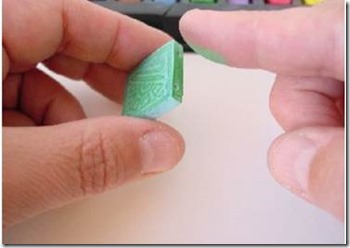It's been a while since I've blogged.
I guess with all the social media such as Facebook and Instagram, which are so easy to access and you can instantly chat with other people, get instant feedback and with a blog...well, one just doesn't know if anyone will even see or read it. Might make a good 'journal' tho? Will have to see if I can revive it...
But here's a test...if you see this, type a comment?
Also...hop on over to Beading Gem. I've got a Giveaway over there as well as a huge Coupon code!
https://www.beadinggem.com/2019/05/beadcombers-20-gift-certificate.html
Happy Creating!
May 28, 2019
Apr 5, 2017
Imitated Nature
For those that don’t know I love to recreate things found on the beach with polymer clay. That’s also where my choice of name ‘Beadcomber’ came from, beachcombing.
I know a couple of my pieces are missing from this photo, namely a sea star or starfish and a whole sea urchin, but I wanted to see how a group shot of my handmade bits would look like. Sea urchin piece, sea glass, driftwood, pebbles, shells and my most recent addition, sand dollar.
The Sea urchin, driftwood and shells are made in a similar way with the help of chalk, the sea glass is made from a liquid form of polymer clay and the sand dollar is caned or made with a method called milifiori which is based on a technique that was originally used in glassworking for making complex designs.
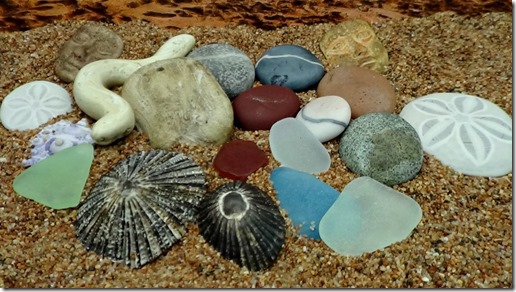
So what is a cane? It’s a log or cylinder of clay that has a design running through it, so each slice of the cane - the cross-section - contains the design. I made a cane that measured approximately 2 inches in diameter and the larger the design, the easier the cane is to handle. It can then be reduced in size by pressing, stretching and rolling it so the cane becomes longer and thinner and the design becomes smaller along with it. Then when cutting slices from the cane, the design will look the same front and back.

I have tutorials on all, except for this and the driftwood. They can be found Here. Just look for the Download Category with Tutorials. If you want some sand dollars or other things, I have them too!
I know a couple of my pieces are missing from this photo, namely a sea star or starfish and a whole sea urchin, but I wanted to see how a group shot of my handmade bits would look like. Sea urchin piece, sea glass, driftwood, pebbles, shells and my most recent addition, sand dollar.
The Sea urchin, driftwood and shells are made in a similar way with the help of chalk, the sea glass is made from a liquid form of polymer clay and the sand dollar is caned or made with a method called milifiori which is based on a technique that was originally used in glassworking for making complex designs.

So what is a cane? It’s a log or cylinder of clay that has a design running through it, so each slice of the cane - the cross-section - contains the design. I made a cane that measured approximately 2 inches in diameter and the larger the design, the easier the cane is to handle. It can then be reduced in size by pressing, stretching and rolling it so the cane becomes longer and thinner and the design becomes smaller along with it. Then when cutting slices from the cane, the design will look the same front and back.

I have tutorials on all, except for this and the driftwood. They can be found Here. Just look for the Download Category with Tutorials. If you want some sand dollars or other things, I have them too!
Mar 22, 2017
Silkscreen + Chalk + Ink + Liquid Polyclay = Faux Ceramic
I was just going through my photos on my computer and while I had posted this tutorial on Facebook, I completely forgot to post it here. It’s not my usual style for a tutorial, but made it as short as possible. If you aren’t into making Christmas or Easter Ornaments, this technique can be used for plenty of other projects including Sun Catchers, Pendants, Bracelets, Boxes etc.
I’ve been making silkscreens for more than 10 years now and they have become very popular for use in polymer clay. Here is one of the earliest techniques I developed using chalk.
Silkscreen + Chalk + Ink + Liquid Polyclay = Faux Ceramic. Enjoy!
For my Silkscreens, check out the nice variety in my Etsy
Nov 2, 2016
Beaders Supplies in Faux Stone, Raku, Batik and other techniques
As you might know I create silkscreens and molds for polymer clay artists, but lately I've also enjoyed making and selling my handmade supplies.
I'm on a bit on a jewelry-making hiatus. Having pinched nerves in my neck don't make for comfort when long hours hunched over beadwork are involved, but I still need to make a living. I'm glad others are enjoying my components and that these do just as well as my jewelry. I have the components available on my Facebook Page Beadcombersupplies. The album with current items is found here:
 |
Aug 4, 2016
Silkscreened Polymer Clay Feathers...a Video Tutorial
Here is a Video Tutorial I made and forgot to post here.
Silkscreens, Pan Pastels and Chalks
When I began to make silkscreens for polymer clay about 10 years ago I never dreamed they would become so popular. The late Gwen Gibson, a Pioneer in the World of Polymer Clay, innovated the use of silkscreens and etching plates with Polymer Clay. Gwen was generous and I was fortunate to chat with her on a couple of occasions. Although I also use acrylic paint, which is the medium Gwen had primarily used with silkscreens, my passion has always been Mica. I then added Chalk and Pan Pastel. I began using Metal Pulvers in 1989 and then moved to the less toxic Mica. Back in 1989 no one told you about wearing a mask when using the pulvers or fine metal shavings and when Jacquard introduced Mica powder for Card making, scrap-booking etc (which we also use in make-up and eyeshadow) this wasn’t necessary. If you use a brush and really go at it, you might want to wear a mask, though. I primarily use my fingers to apply.
For many years I sold this tutorial, but have decided to share some of my older tutorials as I develop newer ones. Enjoy!
“Low Relief Stone Rubbings”
by Tina Holden (2008)
This is an older tutorial, but still valid. I just reformatted the layout of the text. Here I will teach you how to create 'low relief stone rubbings' on Polymer Clay. These stone rubbings are based on grave stone rubbings, but aren't as morbid. Instead you'll discover various ways and possibilities with this technique using silkscreens or stencils.

Tools:
● Tissue blades, rigid and flex (flex is optional)
● Pasta Machine (Atlas 150 used in examples)
● Needle tool or knitting needle
● Silkscreens or stencils
● round, oval or square cutters (optional)
● Flat soft bristle paintbrush
● Oven
● Baking tile or glass
● White unlined paper or card stock to bake on
● Thin Foam texture sheet or other suitable texture such as silken fabric or tulle
● Armorall as release agent
● Baby wipes or Windex for clean-up
● gloves (optional)
Materials:
● Premo! Polymer Clay: 1 small block each of white, translucent or frost, pearl and either Turquoise
Blue or Sea green (note: Sea Green is no longer available)
● Fimo Gloss or Fimo Water based Varnish
● Decorator Chalks (or pastel powder eye make-up in cobalt blue, bright green and yellow) or Pan Pastels in similar colours
● Jacquard PearlEx Mica Powder in Turquoise (optional)
● Embossing powder in green, blue or verdigris
The clay I prefer is Premo but you can use any of the other brands if you prefer, although for jewelry I don't recommend Sculpey III as it is too brittle for thinner pieces. (note…this is the older Premo packaging)
Preparing the Clay base:
Step 1. Mix ½ block each of white, translucent, and pearl with ¼ block of turquoise or sea-green. Roll through Pasta machine on thickest setting (#1 on Atlas)
Step 2. Blend clay with 1 tsp. of embossing powder.

Step 3.Blend clay with ¼ tsp. of Turquoise Mica Powder (optional). Roll through pasta machine on thickest setting (#1 on Atlas).
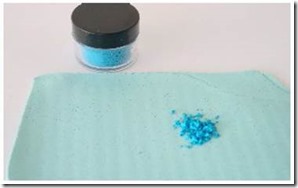
Step 4. Cut sheet in half and lay one half aside. Prepare Silkscreen by using a little Armorall on finger and spread over the 'rubbery' side of the screen. This will prevent the fine mesh from clogging up with clay. Roll out on smaller setting, next size down, #2 on Atlas.

Step 5. Stack Silkscreen – shiny side down onto prepared clay sheet, with foam texture or tulle at backside of clay. Roll through pasta machine on thickest setting (#1 on Atlas).
Step 6. Peel off Silkscreen and texture. You should get a low relief or stamp-like texture on your clay. (I’ve darkened the first photo so you might be able to see the texture a little better)

Colouring the relief texture:
Step 7. Lightly cover finger or gloved finger with chalk and gently stroke or rub
Colour onto your textured sheet. Don't apply too much pressure as you will want to keep your texture intact. Start with one colour and apply in various places on the relief. I used green chalk here.

Step 8. Then apply another colour/s. Second colour I used is blue, third I used yellow. Cover entire sheet until you are pleased with the effect. You may have to go over the surface with more powder to darken it. It doesn't really matter if you apply some green over the blue, it'll actually turn it into a nice teal.

Step 9: Take sheet that you laid aside earlier and roll out at #2 setting and then texture one side with foam texture or tulle. Remove foam or tulle and carefully lay your coloured relief rubbing sheet onto the sheet you textured (texture side down), avoiding trapping air bubbles.

Step 10: Trim away rough edges. Any of the coloured scraps put aside to roll into matching beads later if you want to.
Step 11: Cut into tiles for Bracelet, Earrings, put holes where you need them. Other creative uses would be for coasters or tiles.
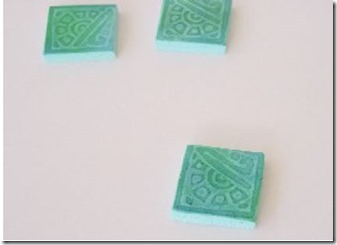
Step 12: When putting in holes horizontally, Hold the tile as shown and maneuver a thin needle or needle tool through the tile, just until it peeks through the other side. Complete the hole by pushing tool through from opposite end. For a bracelet you'll need about 5 to 7 tiles, it depends on what size beads you use as spacers, on wrist size as well as the tile size. I do have a tile bead tutorial on both my website and Etsy (links below)

Step 13: Rub some chalk or pastel on the sides and back of the bead tiles also.
Step 14: Bake, Let cool and varnish, then string with elastic. Tie knots and hide knots inside large-hole glass beads.

Note: you can roll your unbaked/uncured stone rubbing through smaller settings to lightly stretch the design which I did with the earrings here.
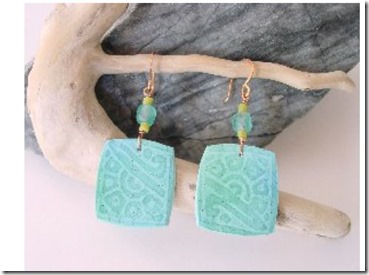
For variation try other colour combos and other patterns.
Variation: mix a different colour clay base such as ½ ecru, ¼ translucent, ¼ pearl, ¼ raw sienna and use chalks in brown and orange. Always use a light colour clay base to bring out the colours of the chalk.
Have Fun creating!!
Tina
For a variety of silkscreens, molds, tutorials etc…
My Etsy: https://beadcomber.etsy.com
For many years I sold this tutorial, but have decided to share some of my older tutorials as I develop newer ones. Enjoy!
“Low Relief Stone Rubbings”
by Tina Holden (2008)
This is an older tutorial, but still valid. I just reformatted the layout of the text. Here I will teach you how to create 'low relief stone rubbings' on Polymer Clay. These stone rubbings are based on grave stone rubbings, but aren't as morbid. Instead you'll discover various ways and possibilities with this technique using silkscreens or stencils.

Tools:
● Tissue blades, rigid and flex (flex is optional)
● Pasta Machine (Atlas 150 used in examples)
● Needle tool or knitting needle
● Silkscreens or stencils
● round, oval or square cutters (optional)
● Flat soft bristle paintbrush
● Oven
● Baking tile or glass
● White unlined paper or card stock to bake on
● Thin Foam texture sheet or other suitable texture such as silken fabric or tulle
● Armorall as release agent
● Baby wipes or Windex for clean-up
● gloves (optional)
Materials:
● Premo! Polymer Clay: 1 small block each of white, translucent or frost, pearl and either Turquoise
Blue or Sea green (note: Sea Green is no longer available)
● Fimo Gloss or Fimo Water based Varnish
● Decorator Chalks (or pastel powder eye make-up in cobalt blue, bright green and yellow) or Pan Pastels in similar colours
● Jacquard PearlEx Mica Powder in Turquoise (optional)
● Embossing powder in green, blue or verdigris
The clay I prefer is Premo but you can use any of the other brands if you prefer, although for jewelry I don't recommend Sculpey III as it is too brittle for thinner pieces. (note…this is the older Premo packaging)
Preparing the Clay base:
Step 1. Mix ½ block each of white, translucent, and pearl with ¼ block of turquoise or sea-green. Roll through Pasta machine on thickest setting (#1 on Atlas)
Step 2. Blend clay with 1 tsp. of embossing powder.

Step 3.Blend clay with ¼ tsp. of Turquoise Mica Powder (optional). Roll through pasta machine on thickest setting (#1 on Atlas).

Step 4. Cut sheet in half and lay one half aside. Prepare Silkscreen by using a little Armorall on finger and spread over the 'rubbery' side of the screen. This will prevent the fine mesh from clogging up with clay. Roll out on smaller setting, next size down, #2 on Atlas.

Step 5. Stack Silkscreen – shiny side down onto prepared clay sheet, with foam texture or tulle at backside of clay. Roll through pasta machine on thickest setting (#1 on Atlas).
Step 6. Peel off Silkscreen and texture. You should get a low relief or stamp-like texture on your clay. (I’ve darkened the first photo so you might be able to see the texture a little better)

Colouring the relief texture:
Step 7. Lightly cover finger or gloved finger with chalk and gently stroke or rub
Colour onto your textured sheet. Don't apply too much pressure as you will want to keep your texture intact. Start with one colour and apply in various places on the relief. I used green chalk here.

Step 8. Then apply another colour/s. Second colour I used is blue, third I used yellow. Cover entire sheet until you are pleased with the effect. You may have to go over the surface with more powder to darken it. It doesn't really matter if you apply some green over the blue, it'll actually turn it into a nice teal.

Step 9: Take sheet that you laid aside earlier and roll out at #2 setting and then texture one side with foam texture or tulle. Remove foam or tulle and carefully lay your coloured relief rubbing sheet onto the sheet you textured (texture side down), avoiding trapping air bubbles.

Step 10: Trim away rough edges. Any of the coloured scraps put aside to roll into matching beads later if you want to.
Step 11: Cut into tiles for Bracelet, Earrings, put holes where you need them. Other creative uses would be for coasters or tiles.

Step 12: When putting in holes horizontally, Hold the tile as shown and maneuver a thin needle or needle tool through the tile, just until it peeks through the other side. Complete the hole by pushing tool through from opposite end. For a bracelet you'll need about 5 to 7 tiles, it depends on what size beads you use as spacers, on wrist size as well as the tile size. I do have a tile bead tutorial on both my website and Etsy (links below)

Step 13: Rub some chalk or pastel on the sides and back of the bead tiles also.
Step 14: Bake, Let cool and varnish, then string with elastic. Tie knots and hide knots inside large-hole glass beads.

Note: you can roll your unbaked/uncured stone rubbing through smaller settings to lightly stretch the design which I did with the earrings here.

For variation try other colour combos and other patterns.
Variation: mix a different colour clay base such as ½ ecru, ¼ translucent, ¼ pearl, ¼ raw sienna and use chalks in brown and orange. Always use a light colour clay base to bring out the colours of the chalk.
Have Fun creating!!
Tina
For a variety of silkscreens, molds, tutorials etc…
My Etsy: https://beadcomber.etsy.com
Aug 1, 2016
Silkscreening technique on crackled foil and Cabezel Molds
Silkscreening technique on crackled foil and Cabezel Molds
There is such a great myriad of techniques that can be used with the Cabezel Molds, you name it! Mokume Gane, Textured and stamped polymer clay, caned veneers, faux stone and so much more and I thought why not try them with Silkscreens!    | Tutorial by Tina Holden I’ll also show you how I silkscreen on metallic crackle. Here I’ll demo how to silkscreen on a simple foil crackle (different than leafing). You can use any silkscreen you have on hand or this Paisley design which can be found HERE. I’ll also show you a tip on how I cut the CaBezel shapes without the use of a tissue blade or knife. I’ll demo a couple of different shapes, one for the frame and another for the cabochon… …and what I like about the CaBezel molds is they have both a frame and a corresponding cabochon mold that fit into the frame. Shadesofclay.com has a large variety found here http://shadesofclay.com/products/molds/cabezels-tools-supplies/ and here http://shadesofclay.com/products/molds/exclusives-molds/ There are 8 Frames and 8 corresponding Stones/cabochons shapes for the “Blocks and Dots” mold, 4 sets are round, 3 are square and 1 set of rectangles. The “Fab Focals1” has 3 sets of wonderful shapes and the “Organics” has 4 sets. There are so many great CaBezel Molds to choose from. Materials:· Polymer Clay: Black Fimo and Silver, White, and Turquoise Blue… or Sculpey Premo in Black, White Gold Glitter, Frost white glitter, Peacock Pearl· Lisa Pavelka foil, iridescent or oilslick · Heavy Body Acrylic Paint in Black · Water and spritz bottle for Premo or… · ArmorAll Original Protectant (found in Automotive section at large Retailer) · Brush for ArmorAll Tools: · Pasta Machine · CaBezel Molds, various styles or shapes that you like. I’m using the Dots ’n Blocks and Fab Focals 1 · Silkscreen: Paisley or other · Acrylic Hand roller · Paint brush · Squeegee or old credit card · Flex tissue blade* · Large round or oval cookie cutter *(optional) · Bucket of warm water to rinse silkscreen |
 | Step 1: Creating the Silkscreen Sheet Mix Premo Peacock Pearl with White Gold Glitter. The White Gold Glitter is very rich and adds a lot of sparkle to the Peacock Pearl. I used a ¼ block of peacock with ¼ of a ¼ block of White Gold Glitter. Roll to largest setting of your PM or #1 on Atlas. |
 | Step 2: Apply Iridescent or Oilslick Foil with shiny patterned side facing up. Burnish onto clay with folded piece of paper. Rub back and forth. The friction of the rubbing produces heat which transfers the foil onto the clay. You don’t have to press hard when rubbing and you don’t need to burnish for very long, maybe 30 seconds. Lift up a corner of the foil to see if it all transferred, if not position back into place and burnish some more. A few odd specks that don’t transfer won’t matter. Remove the mylar/plastic film from the clay. |
 | Step 3: Roll clay through at #2 (next smallest setting after #1 on Atlas PM), rotate the clay ¼ turn and roll through to #3, which is thinner yet. This is what the sheet and crackle will look like. |
 | Step 4: Silkscreening onto Polymer Clay Place the silkscreen with the shinier side face down on the clay. The shinier side is also slightly textured. For some it is hard to differentiate which side is which, but I mark my screens with a tiny sticker and provide instructions with each screen. The type of paint you use is also important. Liquid or thin bodied paints will not work as they’ll run through the mesh and won’t keep the pattern. Heavy body acrylic paint works best. Apply a strip of paint. A little goes a long way and if it’s not enough more paint can be applied. |
 | Step 5:Use a squeegee or old credit/phone card to apply paint over surface. |
 | Step 6: You can check to see if paint has been transferred to the clay through the entire mesh of the silkscreen by lifting a corner of the screen and peeling it back a bit. If there are some spots that require more paint place the screen back down, and apply a bit more paint. You could use your finger to apply paint through the screen at that spot. If the transfer of paint is complete, remove the screen and place it into a container of lukewarm water. Take care of your screen by not allowing the paint to dry onto it. After the screen is washed, dab it dry with a paper towel and lay it on a tile or shelf with the shiny side facing up. (Don’t place it shiny side down as it might ‘glue’ itself to the surface and you’d have to wet it well for removal. Mistakes happen). If you want to reuse the screen as soon as possible, give it a quick blow-dry on a cool to warm setting, but avoid hot or the screen could ripple from the heat. |
 | Step 7: Beautiful pattern on an iridescent crackle. Let the paint dry. Should take only about 30 minutes or so. |
 | Step 8: Making the Cabochon Using the CaBezel mold, spray it with water or if using Fimo clay, brush it with a bit of Armorall (Water renders Fimo sticky). You could use Corn-starch but I find ArmorAll works well with any photopolymer, plastic and even polymer clay mold. Press clay into the mold. It’s ok if it overlaps or spreads over the side of the mold. I used 2 thicknesses of clay at #2 setting on the pasta machine. You could use scrap clay for this as this part of the clay will get veneered or covered with the silkscreened clay. |
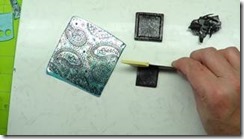 | Step 9: Trim the edges of what will become the ‘filler clay’. (Ignore the frame clay piece above the piece that I’m cutting here, we’ll get to that) |
 | Step 10: CaBezels are see-through so you can choose a section you want for your pendant. Firmly press the CaBezel over the part to mark the cutting lines. Cut out the shape, using an Exacto blade knife or tip of the tissue blade. |
 | Step 11: Note I’m using a different shape here. This one here is from the “Fab Focals 1” set Place the silkscreened shape over the filler clay. Smooth the edges and sides so they touch the work surface. This will give your cabochon/stone a domed effect. |
 | Step 12: You can also pick up the cabochon piece to manipulate the veneer edges over the sides of the filler clay. You could then cure/bake the piece at this point, but I prefer to have an oven full of pieces as I don’t like to waste electricity. |
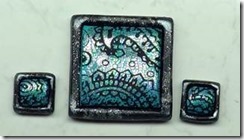 | Step 13: Making the CaBezel Frame… The pendants shown here are from the “Blocks and Dots” CaBezel Set, but I’ll be demoing a shape from the “Fab Focals 1” as a square shape is so easy to cut out with a tissue blade, but I want to show you a trick I use for more complex shapes. Coming up… |
 | Step 14: Condition 2 segments of Black Fimo clay (or ¼ package of black Premo). Put it aside and condition ½ segment of White Gold Glitter Premo. Then mix the 2 colours together by either marbling or with a Skinner blend. |
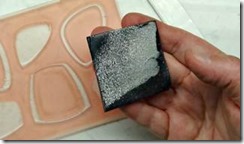 | Step 15: This way you see plenty of sparkle, but still see some of the black also. |
 | Step 16: Roll clay out to #2 on machine and fold in half. Basically you’re repeating step 8 except you would now choose the CaBezel frame that corresponds with the cabochon or stone you created…unless you are making a bunch of frames and cabochons and want to mix and match later. |
 | Step 17: Spritz your CaBezel mold with water for Premo or as before brush with ArmorAll if using Fimo. |
 | Step 18: There are a couple of other methods to create the frame from what I demonstrated in step 8. Use a piece of paper on your work surface to work on as it prevents the clay from sticking onto your tile. If you forget the paper, as I sometimes do, you can use the tissue blade to slide under the clay to lift it from the work surface. One way to create the shape is to press the CaBezel mold onto the clay with your fingers and firmly press the sides. Don’t roll over the clay with a hand-roller as that will stretch the clay and shift it from the recess of the CaBezel and cause a double lip. Try it and you’ll see what I mean, lol. A much better way… |
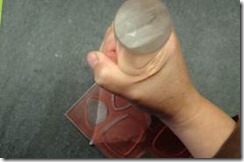 | Step 19: … which works really well and is a great tip from Wendy, is to use the hand roller end. Wendy explains to hold it in your fist and rub in every direction until you can see the clay is up into the mold. This way you get a great impression and shape. Thanks Wendy, this is absolutely the easiest way! |
 | Step 20: So, there are a couple of ways to cut out the shape. One is using a flex blade. Another would be using an Exacto (x-acto) knife or… |
 | Step 21: Here is my trick! Use a cutter! Choose a cutter that is larger than the CaBezel shape and has rounded sides. I have so many styles of cutters that using them to cut out the shapes is much easier than using an Exacto knife or tissue blade. A Football shape cutter would also work here. |
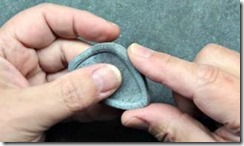 | Step 22: Smooth the edges of the frame with your finger. |
 | Step 23: Insert the silkscreen shape / cabochon from step 11. Because the Frame hasn’t been cured yet you can push or nudge the frame edges to fit the sides of the silkscreened cabochon. Also, because the cabochon hasn’t been cured yet, it will stick to the frame without the use of glue or Liquid clay. Cure/bake/harden to clay manufacturers recommended time and temperature. Because I used both Fimo and Premo in this project and Fimo cures at a slightly lower temperature than Premo, I use the Fimo temperature for curing, but extend the time by about 10 to 15 minutes longer. In general when you cure Fimo at a higher than recommended temperature the colour will darken, but with black this doesn’t affect the colour J Have fun. |
Here are a few more Cabezel pieces that also fit some of the other items that ShadesofClay has available, for instance, a very cool Keychains with bottle opener and a purse hanger! Purse hangers are handy at Restaurants when you don’t know where to put your purse, simply hang it from the table!   | I hope you enjoyed this tutorial. Share with your friends… Copyrights 2016 Tina Holden  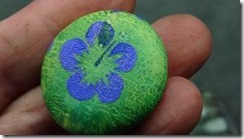 |

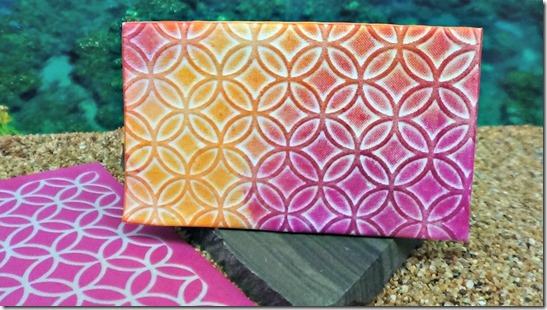
…go have a look Here . You can message me on Facebook through my Supply Page or Tutorial Page
And...if you want to know how I do the colouring method shown in the last 2 photos, it's a technique I developed in 2007 with the lowly but effective chalk pastel. While I still use chalk for a more subtle effect I love using Pan Pastel as they are super-rich, ultra soft...you should try them if you haven't already. So many fun possibilities.
Subscribe to:
Posts (Atom)










